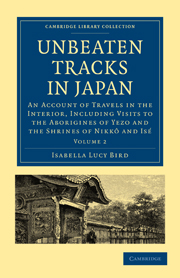 Unbeaten Tracks in Japan
Unbeaten Tracks in Japan Published online by Cambridge University Press: 05 October 2010
Scholars hesitate to decide whether Shintô is or is not “a genuine product of Japanese soil.” The Japanese call their ancient religion kami no michi (the way of the gods); foreigners adopt the Chinese form of the same, and call it Shintô. By Shintô is meant the primitive religion which was found spread over Japan when the Buddhist propagandists arrived in the sixth century, and which, at the restoration of the Mikado to full temporal power, in 1868, became once more the “State religion.” By “Pure Shintô” is meant the ancient faith as distinguished from that mixture of it with Buddhism and Confucianism which is known as Riyôbu Shintô, and it is of pure Shintô that I present my readers with a few notes, in order, if possible, to make the religious allusions in foregoing letters interesting and intelligible.
Japanese cosmogony and mythology are one, and in both Japan is the Universe. There are three confused mythical periods, during which the islands of Japan and many gods were called into being. The third of these begins with the supremacy of Amaterasu, the Sun-Goddess, the great divinity of the Shintô religion. This “heaven-lighting” divinity, finding that Japan was disturbed by the unending feuds of the earthly gods, among whom Okuninushi, their ruler, could not keep order, despatched Ninigi-no-Mikoto, a heavenly god, to Higa in Kiushiu, and compelled Okuninushi to resign his disorderly rule into his hands.
To save this book to your Kindle, first ensure [email protected] is added to your Approved Personal Document E-mail List under your Personal Document Settings on the Manage Your Content and Devices page of your Amazon account. Then enter the ‘name’ part of your Kindle email address below. Find out more about saving to your Kindle.
Note you can select to save to either the @free.kindle.com or @kindle.com variations. ‘@free.kindle.com’ emails are free but can only be saved to your device when it is connected to wi-fi. ‘@kindle.com’ emails can be delivered even when you are not connected to wi-fi, but note that service fees apply.
Find out more about the Kindle Personal Document Service.
To save content items to your account, please confirm that you agree to abide by our usage policies. If this is the first time you use this feature, you will be asked to authorise Cambridge Core to connect with your account. Find out more about saving content to Dropbox.
To save content items to your account, please confirm that you agree to abide by our usage policies. If this is the first time you use this feature, you will be asked to authorise Cambridge Core to connect with your account. Find out more about saving content to Google Drive.